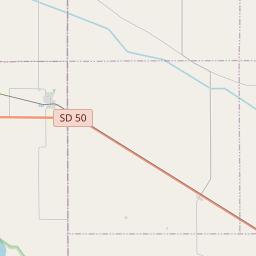First Capitol Building of Dakota Territory
Historical marker location:
200 E 4th St, Yankton, South Dakota
( Marker is at the intersection of Capital Street and East 4th Street (State Highway 50), on the right when traveling north on Capital Street.)
Marker installed: 1925







© OpenStreetMap contributors
South Dakota was the first state in the United States to grant women the right to vote, in 1890.
About Yankton County
Yankton County Timeline
Yankton County, located in the southeastern part of South Dakota, has a rich and diverse history that dates back thousands of years. The area was first inhabited by Indigenous cultures, such as the Yankton Sioux tribe, who hunted and fished along the Missouri River. European exploration of the area began in the late 17th century, with French traders and fur trappers establishing contact with Native American tribes.
In 1803, the Louisiana Purchase brought the region under the control of the United States, and the Lewis and Clark expedition passed through what is now Yankton County in 1804. This led to increased American presence in the area, and in 1859, Yankton was officially designated as the capital of the Dakota Territory. The County was established in 1862, during the early stages of the American Civil War.
Yankton County played a significant role in the development of the Dakotas. It served as the territorial capital until 1889 when South Dakota became a state. The county saw rapid growth during this time, with the construction of railroads and the establishment of businesses. Agriculture, including farming and livestock, formed the backbone of the local economy, and Yankton became a major center for trade and commerce.
Over the years, Yankton County has faced various challenges and changes. The decline of the agricultural sector in the early 20th century led to a shift towards other industries like manufacturing and healthcare. Today, the county continues to thrive as a vibrant community, with a strong emphasis on education, tourism, and outdoor recreational activities. Overall, the history of Yankton County reflects the dynamic nature of American expansion and the resilience of its inhabitants.
In 1803, the Louisiana Purchase brought the region under the control of the United States, and the Lewis and Clark expedition passed through what is now Yankton County in 1804. This led to increased American presence in the area, and in 1859, Yankton was officially designated as the capital of the Dakota Territory. The County was established in 1862, during the early stages of the American Civil War.
Yankton County played a significant role in the development of the Dakotas. It served as the territorial capital until 1889 when South Dakota became a state. The county saw rapid growth during this time, with the construction of railroads and the establishment of businesses. Agriculture, including farming and livestock, formed the backbone of the local economy, and Yankton became a major center for trade and commerce.
Over the years, Yankton County has faced various challenges and changes. The decline of the agricultural sector in the early 20th century led to a shift towards other industries like manufacturing and healthcare. Today, the county continues to thrive as a vibrant community, with a strong emphasis on education, tourism, and outdoor recreational activities. Overall, the history of Yankton County reflects the dynamic nature of American expansion and the resilience of its inhabitants.
Yankton County Timeline
This timeline provides a condensed summary of the historical journey of Yankton County, South Dakota.
- 1800 - The Yankton Sioux Tribe is the initial inhabitant of the area now known as Yankton County.
- 1804 - The Lewis and Clark expedition visit the area and establish diplomatic relations with the Yankton Sioux Tribe.
- 1859 - The first temporary white settlement is established in what is now Yankton County.
- 1861 - Yankton County is officially organized and named after the Yankton Sioux Tribe.
- 1868 - The signing of the Treaty of Fort Laramie guarantees the reservation lands of the Yankton Sioux Tribe.
- 1870 - Yankton becomes the capital of Dakota Territory.
- 1882 - The construction of the first railroad line into Yankton County.
- 1889 - South Dakota becomes a state, with Yankton County as one of its original counties.
- 1920 - Yankton College is founded, becoming an important educational institution in the county.
- 1954 - The construction of the Gavins Point Dam and Lewis and Clark Lake begins, providing recreational and economic benefits to Yankton County.
- 1974 - The creation of the Yankton Sioux Reservation through land consolidation efforts.